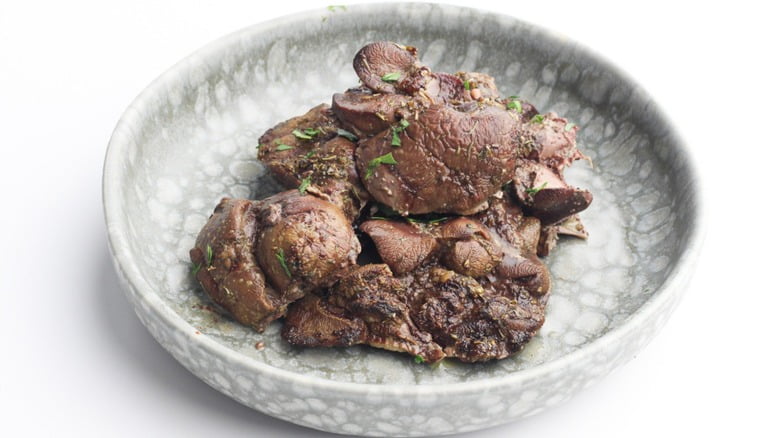How to Cook Chicken Liver For Cats

Our pets rely on us to provide them with the best possible care, and nutrition plays a vital role in their overall well-being. As obligate carnivores, cats require a diet rich in high-quality protein to thrive. Among the various protein sources available, chicken liver emerges as a standout option due to its exceptional nutritional profile. This article will teach you how to cook chicken liver for cats.
By following these guidelines, you can ensure that the chicken liver is not only delicious but also safe and nutritionally balanced. So, let’s dive into the world of culinary delights for our beloved cats and learn how to prepare this delectable treat!
Understanding the Nutritional Value of Chicken Liver
When it comes to providing optimal nutrition for your cat, chicken liver is a fantastic choice. It offers a powerhouse of essential nutrients that can have a significant positive impact on their overall health. One of the primary benefits of chicken liver is its high-quality protein content. Protein is vital for cats as it supports the maintenance of lean muscle mass, helps with healthy growth, and provides the necessary building blocks for various bodily functions.
In addition to protein, chicken liver is abundant in essential vitamins that are crucial for your cat’s well-being. Vitamin A, for example, plays a pivotal role in maintaining healthy skin and coat, supporting good vision, and boosting immune function. Vitamin B12, on the other hand, contributes to the formation of red blood cells, proper nerve function, and overall vitality. By incorporating chicken liver into your cat’s diet, you can help ensure they receive an ample supply of these important vitamins.
Chicken liver is also a rich source of minerals that are essential for your cat’s optimal health. Iron, for instance, is necessary for proper oxygen transportation in the body and helps prevent anemia. Zinc is crucial for maintaining a robust immune system, supporting wound healing, and promoting healthy skin. Selenium, an antioxidant mineral, assists in protecting cells from damage and contributes to overall well-being.
By including chicken liver in your cat’s diet, you provide them with a nutrient-dense food that supports their growth, vitality, and overall health. While it may not be as easy to cook as raw chicken for cats, it is a worth while treat for your pet.
Sourcing and Preparing Chicken Liver

When it comes to sourcing chicken liver for your cat, prioritizing quality is key. Look for reputable suppliers that offer organic or trusted sources of chicken liver. Opting for high-quality liver ensures that your cat receives the best possible nutrients without any harmful additives or contaminants. Fresh chicken liver should have a deep reddish-brown color and a firm texture. Avoid liver that appears discolored, has an off-putting odor, or feels excessively soft or slimy.
Before cooking the chicken liver, it’s crucial to maintain proper hygiene. Therefore, make sure to follow these steps:
- Rinse the liver under cool water
- Begin by rinsing the chicken liver thoroughly under cool water.
- This step helps remove any surface impurities or residues that may be present.
- Ensure the water runs clear before proceeding to the next step.
- Pat dry with a paper towel or clean cloth
- After rinsing, gently pat the chicken liver dry with a paper towel or clean cloth.
- This helps remove excess moisture and prepares the liver for further preparation.
- Make sure to handle the liver with clean hands or utensils to maintain hygiene.
- Trim off visible fat and connective tissues
- Examine the chicken liver and trim off any visible fat or connective tissues.
- Excessive fat can be challenging for cats to digest and may lead to digestive issues.
- Removing these unwanted parts ensures that your cat receives the most nutrient-dense portions of the liver.
- Proceed with cooking
- Once the chicken liver is rinsed, dried, and trimmed, it is ready to be cooked.
- Follow your preferred cooking method, such as boiling or baking, to prepare the liver for your cat’s enjoyment.
- Remember to cook it thoroughly to ensure it is safe and retain its nutritional value.
By sourcing high-quality chicken liver and practicing proper hygiene during preparation, you can ensure that your cat receives the best possible nutritional benefits from this delicious treat. Taking these steps not only supports their health but also provides you with peace of mind knowing that you are providing a safe and wholesome meal for your feline friend.
Cooking Methods for Chicken Liver

Here are the two best ways to cook chicken liver for cats: boiling and baking. Both methods are simple, effective, and ensure that the chicken liver is thoroughly cooked while retaining its nutritional value.
Boiling involves gently simmering the liver in water, while baking allows the liver to cook in the oven, enhancing its flavor. Whether you choose to boil or bake the chicken liver, both methods offer a delicious and nutritious treat for your feline companion. Let’s explore these cooking methods in detail to provide your cat with a mouthwatering and wholesome dining experience:
A. Boiling

Boiling is a simple and effective method for cooking chicken liver. It is a great option for ensuring thorough cooking while reducing the fat content. To prepare chicken liver using this method, follow these steps:
- Place the chicken liver in a saucepan: Start by placing the chicken liver in a saucepan or pot.
- Add enough water to cover the liver: Pour enough water into the saucepan to completely cover the liver. This will ensure even cooking and help remove any remaining impurities.
- Bring the water to a gentle boil: Place the saucepan over medium heat and bring the water to a gentle boil. Avoid boiling it vigorously, as this may cause the liver to become tough or overcooked.
- Cook for approximately 10 to 15 minutes: Allow the liver to simmer in the gently boiling water for about 10 to 15 minutes. This cooking time ensures that the liver is thoroughly cooked and safe for consumption.
- Let the liver cool before serving: Once the liver is cooked, remove it from the heat and let it cool before serving it to your cat. Ensure that the liver has cooled down sufficiently to avoid any burns or discomfort.
B. Baking

Baking chicken liver is another excellent cooking method that helps retain its nutritional value while enhancing its flavor. Here’s how you can bake chicken liver for your feline friend:
- Preheat your oven: Preheat your oven to 350°F (175°C) to ensure it reaches the desired temperature for baking.
- Prepare a baking dish: Lightly grease a baking dish to prevent the liver from sticking. This will make it easier to remove the liver once it’s cooked.
- Arrange the liver in the baking dish: Place the chicken liver evenly in the greased baking dish, ensuring they are in a single layer for even cooking.
- Season the liver: For added flavor, you can season the liver with a sprinkle of cat-friendly herbs like catnip or a small amount of unsalted chicken broth. This will enhance the taste and make it even more enticing for your cat.
- Bake for 15 to 20 minutes: Place the baking dish in the preheated oven and bake the liver for about 15 to 20 minutes. Keep an eye on it to prevent overcooking. The liver should be cooked through but still tender.
By following these cooking methods, you can prepare chicken liver in a way that retains its nutritional value and ensures it is safe for your cat to enjoy. Remember to let the liver cool down before serving it, and always consider your cat’s preferences and dietary needs when choosing the cooking method and seasonings.
Adding Variety and Enhancing the Flavor
To enhance the flavor of chicken liver and introduce some variety to your cat’s diet, you can try the following:
- Cooked Vegetables: Consider adding small amounts of cooked vegetables like peas or carrots to the chicken liver dish. These vegetables can provide additional nutrients and add a different texture to the meal. However, remember to keep the proportion of vegetables small compared to the liver, as cats are obligate carnivores and require meat as their primary source of nutrition.
- Incorporate Plain Rice: Mix in a small amount of plain rice to the chicken liver mixture. Rice can offer some added texture and variety to the dish, making it more appealing to your cat. Just make sure not to include too much rice, as cats primarily require animal protein in their diet. Additionally, make sure you are aware of these 6 facts before feeding your cat some rice.
Remember to introduce new ingredients gradually, monitoring your cat’s response and ensuring they tolerate the additions well. If you have any concerns about specific ingredients or dietary requirements, consult your veterinarian for personalized advice based on your cat’s unique needs.
By incorporating these variations, you can provide your cat with an exciting and flavorful meal while ensuring they still receive the necessary nutrients from the chicken liver.
Alternatively, you can also feed your cat beef liver (which is equally beneficial), or even serve both chicken and beef liver at the same time for some variety.
Feeding Guidelines and Storage
Proper portion control is important when it comes to feeding chicken liver to your cat. While it is a nutritious treat, treats should only make up a small portion of your cat’s overall diet. For an average-sized cat, a small piece of cooked chicken liver once or twice a week is generally enough to provide the benefits of this nutrient-rich organ meat.
To maintain freshness and prevent spoilage, it’s essential to store cooked chicken liver properly. After cooking, place the liver in an airtight container and store it in the refrigerator. This helps preserve its flavor and nutritional value. It’s recommended to consume the cooked liver within a few days to ensure its freshness.
If you have cooked a larger quantity of chicken liver or want to prepare it in advance, freezing is a convenient option. Divide the liver into small portions and store them in airtight containers or freezer bags. Label them with the date for easy reference. When you want to serve the frozen liver, thaw it in the refrigerator overnight or use the defrost setting on your microwave. It’s important to thaw frozen liver thoroughly before serving it to your cat.
By following these feeding guidelines and storage practices, you can ensure that your cat enjoys chicken liver in moderation while maintaining its freshness and quality.
Conclusion
Cooking chicken liver for cats is a fantastic way to offer a nutritious and enjoyable treat to your feline companion. Its high protein content and rich nutrient profile make it a valuable addition to their diet. By following the proper cooking techniques, sourcing high-quality liver, and incorporating variety, you can ensure that your cat receives the maximum benefits from this nutrient-dense organ meat.
Remember to maintain proper hygiene during the preparation process, such as rinsing the liver and trimming off excess fat or connective tissues. Boiling or baking the chicken liver are two excellent cooking methods that help retain its nutritional value while enhancing its flavor.
Feeding guidelines, such as portion control and moderation, are essential to maintain a balanced diet for your cat. Store cooked chicken liver properly in the refrigerator or freezer to ensure freshness and prevent spoilage.
By cooking chicken liver for your feline friend, you can provide them with a safe, healthy, and delicious culinary experience. So, go ahead and treat your cat to the delights of cooked chicken liver, and witness their enjoyment as they savor this nutritious delicacy.


